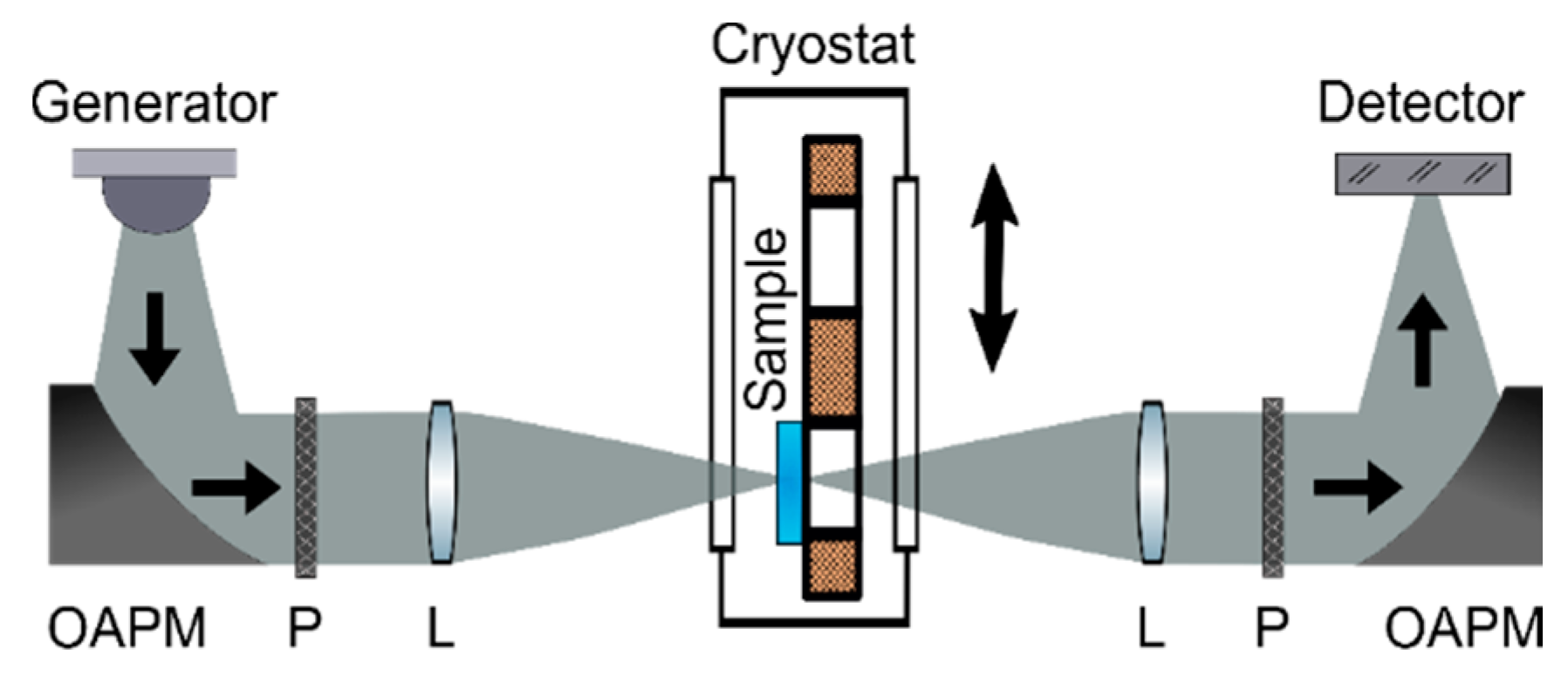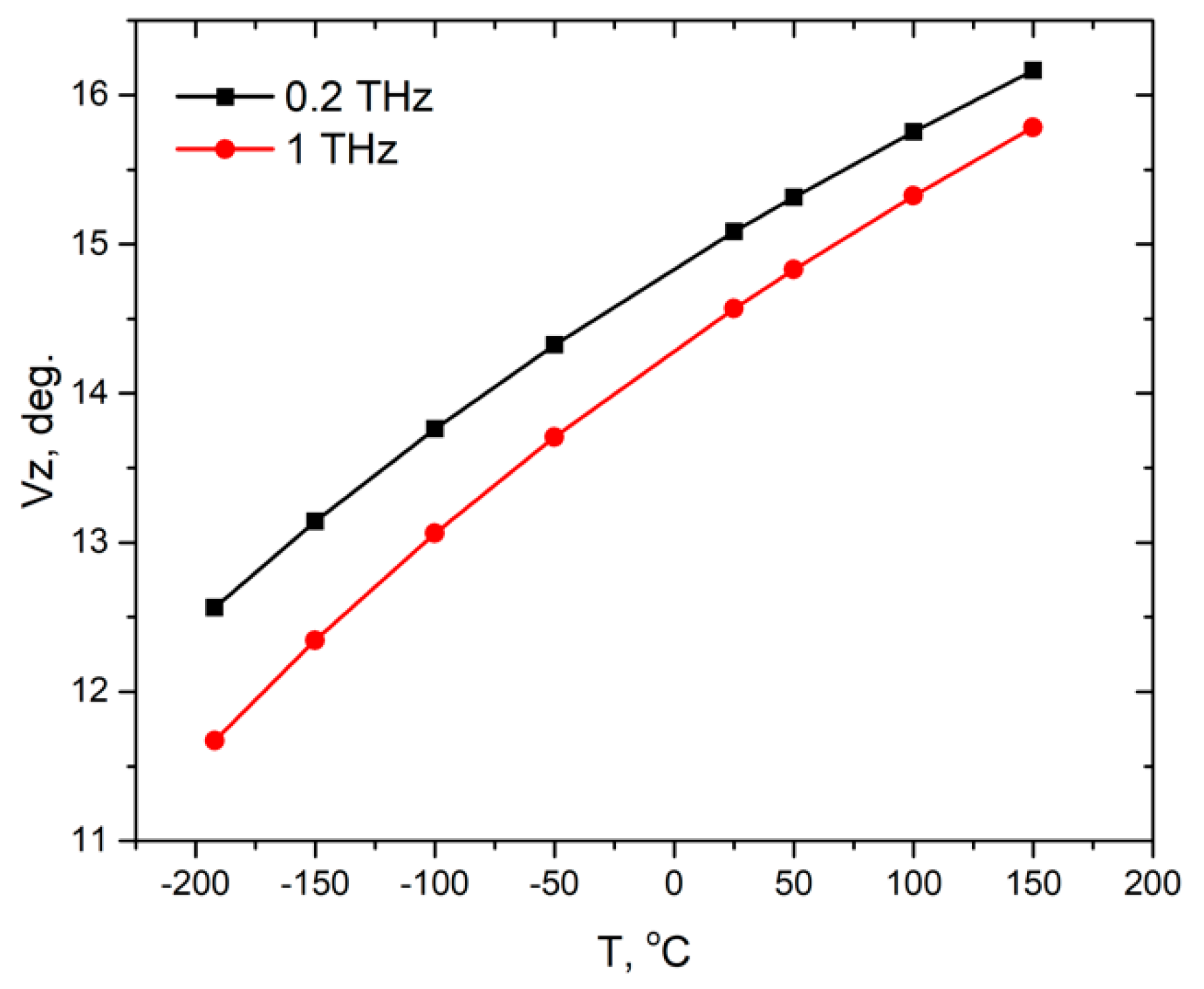Terahertz Optical Properties of KTiOPO4 Crystal in the Temperature Range of (−192)–150 °C
Abstract
:1. Introduction
2. Materials and Methods
3. Results
Bi(T) = B0i + δBiT
Ci(T) = C0i + δCiT
4. Conclusions
Author Contributions
Funding
Informed Consent Statement
Acknowledgments
Conflicts of Interest
References
- Bolt, R.J.; van der Mooren, M. Single Shot Bulk Damage Threshold and Conversion Efficiency Measurements on Flux Grown KTiOPO4 (KTP). Opt. Commun. 1993, 100, 399–410. [Google Scholar] [CrossRef]
- Nikogosyan, D.N. Nonlinear Optical Crystals: A Complete Survey; Springer: New York, NY, USA, 2005; pp. 54–60. ISBN 0387220224. [Google Scholar]
- Antsygin, V.D.; Kaplun, A.B.; Mamrashev, A.A.; Nikolaev, N.A.; Potaturkin, O.I. Terahertz Optical Properties of Potassium Titanyl Phosphate Crystals. Opt. Express 2014, 22, 25436. [Google Scholar] [CrossRef]
- Mamrashev, A.; Nikolaev, N.; Antsygin, V.; Andreev, Y.; Lanskii, G.; Meshalkin, A. Optical Properties of KTP Crystals and Their Potential for Terahertz Generation. Crystals 2018, 8, 310. [Google Scholar] [CrossRef] [Green Version]
- Huang, J.-G.; Huang, Z.-M.; Nikolaev, N.A.; Mamrashev, A.A.; Antsygin, V.D.; Potaturkin, O.I.; Meshalkin, A.B.; Kaplun, A.B.; Lanskii, G.V.; Andreev, Y.M.; et al. Phase Matching in RT KTP Crystal for Down-Conversion into the THz Range. Laser Phys. Lett. 2018, 15, 075401. [Google Scholar] [CrossRef]
- Nikolaev, N.A.; Lansky, G.V.; Andreev, Y.M.; Ezhov, D.M.; Krekov, M.G.; Lisenko, A.A. β-BBO, LBO, AND KTP Nonlinear Crystals as Sources of Millimeter-Wave Radiation. Russ. Phys. J. 2020, 63, 1025–1029. [Google Scholar] [CrossRef]
- Wu, M.-H.; Tsai, W.-C.; Chiu, Y.-C.; Huang, Y.-C. Generation of ~100 KW Narrow-Line Far-Infrared Radiation from a KTP off-Axis THz Parametric Oscillator. Optica 2019, 6, 723. [Google Scholar] [CrossRef]
- Wu, M.-H.; Chiu, Y.-C.; Wang, T.-D.; Zhao, G.; Zukauskas, A.; Laurell, F.; Huang, Y.-C. Terahertz Parametric Generation and Amplification from Potassium Titanyl Phosphate in Comparison with Lithium Niobate and Lithium Tantalate. Opt. Express 2016, 24, 25964. [Google Scholar] [CrossRef]
- Bigourd, D.; Cuisset, A.; Hindle, F.; Matton, S.; Fertein, E.; Bocquet, R.; Mouret, G. Detection and Quantification of Multiple Molecular Species in Mainstream Cigarette Smoke by Continuous-Wave Terahertz Spectroscopy. Optics Lett. 2006, 31, 2356. [Google Scholar] [CrossRef]
- Hsieh, Y.D.; Nakamura, S.; Abdelsalam, D.G.; Minamikawa, T.; Mizutani, Y.; Yamamoto, H.; Iwata, T.; Hindle, F.; Yasui, T. Dynamic Terahertz Spectroscopy of Gas Molecules Mixed with Unwanted Aerosol under Atmospheric Pressure Using Fibre-Based Asynchronous-Optical-Sampling Terahertz Time-Domain Spectroscopy. Sci. Rep. 2016, 6, 28114. [Google Scholar] [CrossRef] [Green Version]
- Mamrashev, A.A.; Maximov, L.V.; Nikolaev, N.A.; Chapovsky, P.L. Detection of Nuclear Spin Isomers of Water Molecules by Terahertz Time-Domain Spectroscopy. IEEE Trans. Terahertz Sci. Technol. 2018, 8, 13–18. [Google Scholar] [CrossRef]
- Zhukov, S.S.; Balos, V.; Hoffman, G.; Alom, S.; Belyanchikov, M.; Nebioglu, M.; Roh, S.; Pronin, A.; Bacanu, G.R.; Abramov, P.; et al. Rotational Coherence of Encapsulated Ortho and Para Water in Fullerene-C60 Revealed by Time-Domain Terahertz Spectroscopy. Sci. Rep. 2020, 10, 18329. [Google Scholar] [CrossRef] [PubMed]
- Nanni, E.A.; Huang, W.R.; Hong, K.H.; Ravi, K.; Fallahi, A.; Moriena, G.; Dwayne Miller, R.J.; Kärtner, F.X. Terahertz-Driven Linear Electron Acceleration. Nat. Commun. 2015, 6, 9486. [Google Scholar] [CrossRef] [Green Version]
- Hafez, H.A.; Kovalev, S.; Tielrooij, K.; Bonn, M.; Gensch, M.; Turchinovich, D. Terahertz Nonlinear Optics of Graphene: From Saturable Absorption to High-Harmonics Generation. Adv. Opt. Mater. 2020, 8, 1900771. [Google Scholar] [CrossRef] [Green Version]
- Cherkasova, O.P.; Serdyukov, D.S.; Ratushnyak, A.S.; Nemova, E.F.; Kozlov, E.N.; Shidlovskii, Y.V.; Zaytsev, K.I.; Tuchin, V.V. Effects of Terahertz Radiation on Living Cells: A Review. Opt. Spectrosc. 2020, 128, 855–866. [Google Scholar] [CrossRef]
- Antsigin, V.D.; Gusev, V.A.; Semenenko, V.N.; Yurkin, A.M. Ferroelectric and Nonlinear Optical Properties of Ferroelectric-Superionic Ktp. Ferroelectrics 1993, 143, 223–227. [Google Scholar] [CrossRef]
- Urenski, P.; Gorbatov, N.; Rosenman, G. Dielectric Relaxation in Flux Grown KTiOPO4 and Isomorphic Crystals. J. Appl. Phys. 2001, 89, 1850–1855. [Google Scholar] [CrossRef]
- Kugel, G.E.; Brehat, F.; Wyncke, B.; Fontana, M.D.; Marnier, G.; Carabatos Nedelec, C.; Mangin, J. The Vibrational Spectrum of a Ktiopo4 Single Crystal Studied by Raman and Infrared Reflectivity Spectroscopy. J. Phys. C Solid State Phys. 1988, 21, 5565–5583. [Google Scholar] [CrossRef]
- Wu, Q.; Zhang, X.C. Free-Space Electro-Optic Sampling of Terahertz Beams. Appl. Phys. Lett. 1995, 67, 3523. [Google Scholar] [CrossRef]
- Mamrashev, A.A.; Potaturkin, O.I. Characteristics of the System of Polarization-Optical Detection of a Pulsed Terahertz Spectrometer. Optoelectron. Instrum. Data Process. 2011, 47, 332–337. [Google Scholar] [CrossRef]
- Duvillaret, L.; Garet, F.; Coutaz, J.L. A Reliable Method for Extraction of Material Parameters in Terahertz Time-Domain Spectroscopy. IEEE J. Sel. Topics Quantum Electron. 1996, 2, 739–745. [Google Scholar] [CrossRef] [Green Version]
- Surovtsev, N.V.; Malinovskii, V.K.; Pugachev, A.M.; Shebanin, A.P. The Nature of Low-Frequency Raman Scattering in Congruent Melting Crystals of Lithium Niobate. Phys. Solid State 2003, 45, 534–541. [Google Scholar] [CrossRef]
- Mounaix, P.; Sarger, L.; Caumes, J.P.; Freysz, E. Characterization of Non-Linear Potassium Crystals in the Terahertz Frequency Domain. Opt. Commun. 2004, 242, 631–639. [Google Scholar] [CrossRef]
- Dmitriev, V.G.; Gurzadyan, G.G.; Nikogosyan, D.N. Handbook of Nonlinear Optical Crystals. In Optical Sciences; Springe: Berlin/Heidelberg, Germany, 1991; Volume 64, p. 16. ISBN 978-3-662-13832-8. [Google Scholar]
- Pálfalvi, L.; Hebling, J.; Kuhl, J.; Péter, A.; Polgár, K. Temperature and Composition Dependence of the Absorption and Refraction of Mg-Doped Congruent and Stoichiometric LiNbO3 in the THz Range. In Proceedings of the Optics InfoBase Conference Papers, Optical Society of America (OSA), Vienna, Austria, 6 February 2005; p. WB4. [Google Scholar]





| Axis | A0 | δA × 10−4, K−1 | B0 | δB × 10−4, K−1 | C0, μm2 | δC, μm2·K−1 |
|---|---|---|---|---|---|---|
| x | 8.89 | 7.32 | 1.35 | 2.65 | 12,848.15 | 1.28 |
| y | 9.14 | 9.36 | 1.31 | 4.54 | 12,857.17 | 1.68 |
| z | 11.08 | 22 | 3.67 | 21.3 | 10,566.31 | 0.83 |
Publisher’s Note: MDPI stays neutral with regard to jurisdictional claims in published maps and institutional affiliations. |
© 2021 by the authors. Licensee MDPI, Basel, Switzerland. This article is an open access article distributed under the terms and conditions of the Creative Commons Attribution (CC BY) license (http://creativecommons.org/licenses/by/4.0/).
Share and Cite
Rybak, A.; Antsygin, V.; Mamrashev, A.; Nikolaev, N. Terahertz Optical Properties of KTiOPO4 Crystal in the Temperature Range of (−192)–150 °C. Crystals 2021, 11, 125. https://doi.org/10.3390/cryst11020125
Rybak A, Antsygin V, Mamrashev A, Nikolaev N. Terahertz Optical Properties of KTiOPO4 Crystal in the Temperature Range of (−192)–150 °C. Crystals. 2021; 11(2):125. https://doi.org/10.3390/cryst11020125
Chicago/Turabian StyleRybak, Alina, Valery Antsygin, Alexander Mamrashev, and Nazar Nikolaev. 2021. "Terahertz Optical Properties of KTiOPO4 Crystal in the Temperature Range of (−192)–150 °C" Crystals 11, no. 2: 125. https://doi.org/10.3390/cryst11020125






